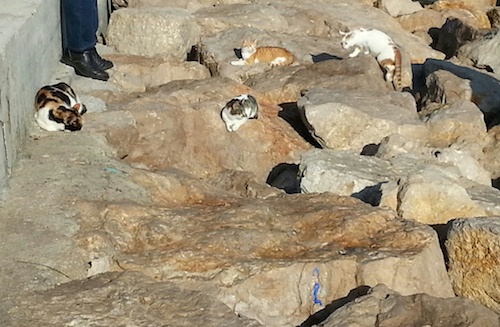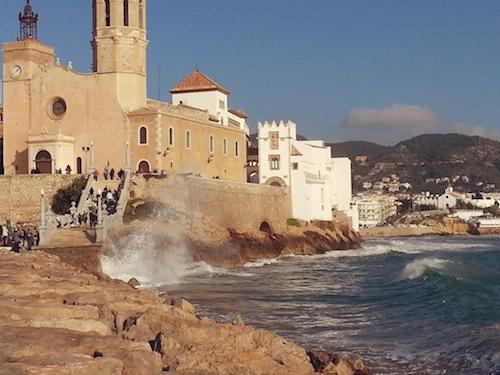T H E D I S T A N C E S and / or C I T I E S (5)

I pose you your question:
shall you uncover honey / where maggots are?
I hunt among stones
- Charles Olson, "The Kingfishers"
This is a family of harbour cats lounging about atop the sea wall at the bottom of the stairs leading up to Sant Bartomeu i Santa Tecla cathedral. It's built upon a promontory beside the Mediterranean in Sitges, Spain. They aren't too interested in anything or anybody other than gathering up what heat there is to feel coming from off the rocks from the winter sun. Whenever a tourist comes close to them they sluggishly jet down into the crevices of rock. Someone local has left out a bowl of dry cat food and water for them further down the jetty, but they don't seem interested in it. The waves are actually crashing with spectacular flourish against these rocks, the water very nearly landing right where these cats languorously do their thing. It's New Year's Day 2015 and the moon's full so the tide is high. The waves won't be anywhere near this large the next day. It looks and feels tremendously impressive. It is impressive.

This cathedral wouldn't stand a chance of lasting for centuries along the rugged California coast against the always turbulent Pacific waters. Highway 1 is continually getting gobbled up. Big Sur becomes unreachable for weeks at a time every decade or so, and just south of San Francisco they finally gave up on a stretch of road known as Devil's Slide, finally putting a tunnel in a couple years ago.
Walking around cities and towns in Spain where buildings such as the cathedral in Sitges and adjacent buildings along narrow lanes surrounding it haven't changed considerably in appearance over a few hundred years is quite the eye opening experience, especially for an American such as myself who has previously never traveled abroad. It calls to mind an interview with poet Kathleen Fraser from out Contemporary Literature where she speaks of her own fascination while in Rome of how certain buildings exposed layers of previous construction, a sort of vision of city built upon city:
I live for regular periods in Rome, where one can walk down a street and see, side by side, buildings built in four or five different centuries. You see pieces of a broken column stuck into a wall when it was rebuilt. If citizens were building something new-say, after the city had been sacked-they reincorporated what remained of their ruined buildings. You can see where odd fragments of "destroyed" works were saved and reframed as fragment and layer. Italians will still always leave a visible section of an original wall in a newly restored house or basement, so you can see the materials of origin, the Roman brick. They don't want to cover it over. When you breathe history every day, it opens up.
We experienced similar sights, especially in Barcelona where we stayed in a small apartment right in the Gothic quarter of the city, just steps from Museu d'Història de Barcelona wherein you actually descend under the current level of the city to view remnants of Roman times. Walking along gangways strung above medieval streets complete with an old wine-making facility, dozens of partial walls, old wells, and remnants of tiled flooring. Here's a rather snazzified youtube video:
I was bummed not to make it out to Mallorca. The only thing that kept us away from the island was the few hundred dollars it would of cost to get to there, not to mention additional cost of a room for the night. I would have dug getting some kind of handle on where several figures of Modern poetry lived and/or visited. There was Laura Riding and Robert Graves, not to mention their secretary for a time, W.S. Merwin, and the young Robert Creeley with his first family in tow who entertained a number of visitors such as Paul Blackburn, plus Robert Duncan and Jess. Yet we're just not jet-setters with abundant cash resources. We were lucky to have our airfare covered, so once we got to Barcelona we kept things on the cheap with local trains and relatively inexpensive rooms, my interest anyway was primarily in simply soaking up the atmosphere and vibe in general of a different locale. Walking about to have a look around.
Wandering through those cobblestone streets I kept thinking how everything was sort of just like parts of Disneyland only it was literally the real deal. You can see what Walt was going for. I've been to American cities, such as Boston and New Orleans, possessing a similar feeling of the accumulative historical weight of human presence, yet none of these urban locales here in The States has the same qualitative heft. Only in the presence of the most raw elements of the landscape in North America have I felt similarly possessed from without by my surroundings as I did everywhere we went in Spain. In North America after all, any remnants of "civilization" reaching back to "Roman times" would be owed directly to original native populations most of which ancestral Europeans did their best to wipe out.
Having grown up all around Orange County in Southern California I experienced the deplorable impact a life surrounded by strip malls and suburbia has upon the active imagination. A state many American youth are well familiar with and which I've always felt the cover art for Bad Religion's album Suffer sums up well.
The only way I ever felt lifted out of a miasma I didn't have the words for was through books, I remember reading the Lord of the Rings trilogy straight through twice and standing in the kitchen after finishing The Godfather declaring to my sister that what was important was "family and friends, in that order, and staying true to that" or something along those lines, and of course the movies were a constant stimulus.
I should also note that skateboarding has always also been a major preoccupation. Rolling around, grinding curbs & benches, ollieing down stairs, over planters, I was able to at least imaginatively interact with my concrete and asphalt surroundings. I don't think there's a finer example of what all this entails than Mark Gonzales's fabulous part in Video Days (Blind Skateboards 1991).
When you watch the video, turn up the volume on those tunes listed in the credits as just "some damn good jazz." Video Days is among the first and most terrific skate videos ever to begin to take the musical accompaniment to the individual skater's part seriously. Watching Gonzales skate, just literally roll and swerve along as he does at the beginning of his part, you get a taste for how fully embodied a part of one's life skating becomes for those both dedicated and fascinated by its intricacies to take it up. There's a reason why in every feature length film or book written documenting skateboarding in some way there's insistent mention of how often skateboarders are found to also be active visual artists, musicians, or writers as well.
At the heart of skateboarding is the natural craving for engagement with your surroundings. Finding a way to make use of this bit of wood or that block of cement. I remember one of my favorite solo skate sessions I've ever had was a couple hours in the front of our house on the day before trash pickup with the pieces of an old busted up desk my folks had discarded. I set it up as various bits of embankment coming up off the curb cuts at the end of our driveway and went to town on it, not justing riding up onto the wall of the desk but also throwing down a bit of lip-trick-city upon the top with pivots, pivot-to-fakie, rock-n-rolls galore, blunts and what not. This was over twenty-five! years ago but I still think about some aspect of that session nearly every day at least for a passing second.
In addition to the muscular, athletic prowess of the body itself, skating demands an endless development of critical skills, enlarging use of the imagination and the visual embrace of space. Nobody else looks at every empty parking lot, university campus, office building complex, or everyday city street like a skateboarder searching for a skate spot offering limitless possibilities. That sort of looking teaches a unique skill-set no lesson plan will ever match. All it takes to apply it elsewhere is the spark of interest in another side of life. Entering into new social and intellectual environments you adapt as you go.
I've never thought of poetry as anything besides a natural continuation of the same interests that led me to skating. It's just an outgrowth of concerns I began developing in my youth. When Amiri Baraka recalls "to see Charles & discuss the past and the present at the same time" in his lecture "Charles Olson and Sun Ra" I feel attuned with and thrilled by the outlook encompassed by such a situation.
This is in no small part due to the versatility of imagination brought my way by skating: to be in the moment of now while also allthewhile aware of it yet without any self-conscious reaching (echoes of Keats's "negative capability") for stability. You're already in the middle of committing the necessary act of doing what you're doing. This is what it means to escape the bounds of time and space.
Baraka's own poems scorch the language up like nobody's business. Always expressing with dapper disdain his state of eternal conflict with the political and cultural mess we're stuck in (at least for now). As he writes of Ed Dorn, "Dorn never thought that poetry excluded him from politics it gave him a way to get inside politics and carve it to the bone." This, too, is Baraka's forte. His poetry represents a continuous precision-skilled deconstruction of the banal and false cultural mirage spread across American society. As the latest posthumous selection of Baraka's poems S.O.S.: POEMS 1961 - 2013 makes readily apparent, Baraka hit all the notes, keeping things sharp and ever tight. A point I attempted in part to make when I recently wrote at some length about the collection. I've long admired Baraka's continual openness to always further developing nuances of his thinking. Like the greatest of skaters, or the greatest of jazz musicians, he never stagnates. The point is to keep going.
Patrick James Dunagan was raised a skateboarder in Southern California and became interested in poetry…
Read Full Biography

